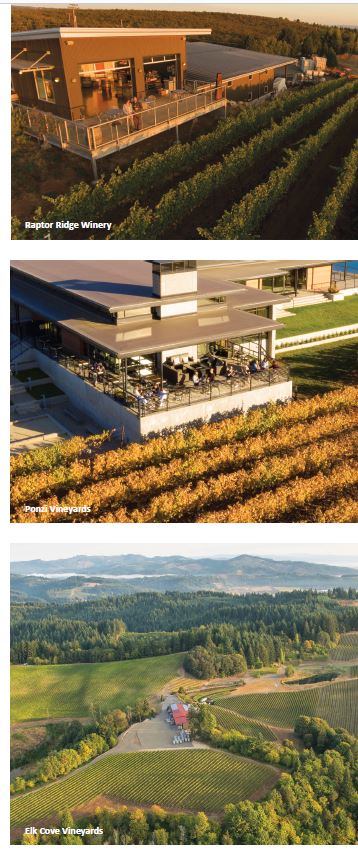In Willamette Valley, Pinot Noir is the undisputed king of grapes. The valley is responsible for 69 percent of the wine grapes grown in the state of Oregon and 81% of that production is Pinot Noir.
The region sits between the Cascade Mountains and the Coast Range. It is more than 100 miles long and up to 60 miles wide with more than 3,000,000 acres within its boundaries, though only a little over 27,000 of those acres are currently under vine.
Pinot Noir is a grape variety that is incredibly reflective of the place that it is grown. It prefers a cool climate and less fertile soil to truly thrive. Small soil and temperature differences can make huge differences in the structure and flavors found in Pinot Noir.
In Bourgogne, the grape’s ancestral home in France, the greater region was delineated into smaller sub-regions and single vineyard designations long ago due to the realization that the grape had different nuances in different places making the wines produced in each unique.
Willamette Valley is no different. Within the greater area, the region acknowledged climatic and geologic differences throughout much of the northern part of Willamette Valley in 2002 and applied to have it divided into six more defined American Viticultural Areas or AVAs which were nested within the original borders of the Willamette Valley AVA that was delineated in 1983.
The first six sub AVAs were Chehalem Mountains, Dundee Hills, Eola-Amity Hills, McMinnville, Ribbon Ridge, and Yamhill-Carlton, and all were fully approved by 2006. The valley would continue to grow and prosper and more wineries and vineyards began to be established both within the original six and also outside in the greater Willamette Valley.
In 2019, the list of subregions expanded with the inclusion of a 35.9-mile triangle of land known as the Van Duzer Corridor. It was added to the list of AVAs to acknowledge an anomaly in the Coast Range that creates a funnel of ocean winds that moderate the region's temperatures and create grapes with thicker skins which give the Pinot Noir of the area more color and more tannins.
 Due to the diverse soils, elevations, and slopes, the area also supports many white grapes as well such as Pinot Blanc, Pinot Gris, and Chardonnay. Recommended producers in this region include Left Coast Cellars and Van Duzer Vineyards.
Due to the diverse soils, elevations, and slopes, the area also supports many white grapes as well such as Pinot Blanc, Pinot Gris, and Chardonnay. Recommended producers in this region include Left Coast Cellars and Van Duzer Vineyards.
In 2020, two new subregions joined the list, the Laurelwood District AVA and Tualatin Hills AVA.
Laurelwood is situated in the northeast facing flank of the Chehalem Mountains and stretches 1,600 feet above sea level. It was delineated specifically for the unique soil type in the area for which the region is named. The windblown loess soil, known as Laurelwood, dominates the area and defines the character of the wine.
With thirty producers and 70 vineyards within this new appellation, finding a taste of the richer style of Pinot Noir that these soils produce is a must for any Pinot Noir lover. The wines show great depth of flavor with a silky feel combined with herbal notes of sage and lavender mingling through the spiced finish. Top producers include Raptor Ridge and Ponzi Vineyards.
Tualatin Hills was designated to highlight the area of the valley that sits in the northernmost hills east of the Coast Range within its rain shadow. This distinctive stretch of 144,000 acres includes the northern hills of the Tualatin River watershed with elevations ranging from 200 to 1,000 feet.
These conditions create an elegant style of Pinot Noir with a balanced structure showing a blue fruit, black pepper character. Currently, there are 40 wineries and vineyards in the region with Elk Cove and Apolloni Estate getting top recommendations.
The latest addition is the Lower Long Tom AVA which was approved in 2021, making it the tenth nested AVA within Willamette and the first in the southern part of the Willamette Valley. This new appellation was drawn to reflect the special features of the area including the Bellpine soils, stream cut ridge lines, and the rain shadow of the Coast Range. It was named after a tributary of the Willamette River.
The Bellpine soils are shallow clay-loam soils formed from ancient marine sediment, primarily sandstone. Expect the Pinot Noir wines from this area to be more generous, velvet textured, and richly flavored. Top producers include Benton-Lane Winery and Brigadoon Winery.
When shopping for these more regionally specific wines, consumers will begin to see both Willamette Valley on the label along with the subregion name. Pinot Noir lovers will enjoy tasting the unique qualities that each area’s terroir nurtures into each glass while considering how things like small elevation changes and different soils contribute to the enjoyment.
The difficult part will be choosing a new favorite.